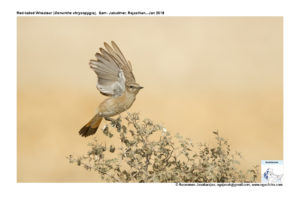Red-tail Wheatear

Red-tailed Wheatear Oenanthe chrysopygia
Etymology:
- Oenanthe : Greek word oinanthe – unidentified bird mentioned by Aristotle
- Chrysopygia : Greek word khrusos- gold ; pugios-rumped.
Vernacular Names: Guj: Lal punch hpiddo, Mar: Lal Shepaticha Rangoja
Distribution in India: Winter visitor to North West India.
Description: Size of 14·5 cm; wt. of 18–29 g. The plumage is greyish-brown from crown to back, with blackish lores to eye, buff preocular supercilium and mid-grey postocular supercilium extending around (rust-tinged) ear-coverts onto chin and breast, and shading to pale brownish on flanks and pale orange-tinged buff on vent. The wings are mid-brown with broad grey-buff fringes, rump and tail are pale rusty, tail has blackish central feathers and terminal band with pale rusty tips. The bill and legs are black. Both the sexes are similar with female being duller. The juvenile is like female but is paler.
Habitat: It breeds on gently angled to steep arid rocky and stony slopes and screes with scattered boulders, stony mountain ridges and ravines, and dry fallow fields in remote valleys, sometimes level boulderfields near small or large perennial streams; dominant vegetation sparse dwarf montane shrubs, In Breeding it’s found from 1200 m – 4000 m. On passage and in winter, it is found in rocky hilly area, warm steppe zones and degraded sub-steppe, in sand-dune areas, clay flats, scrub desert, low stony hills and rocky ravines. In non-breeding times found from sea level to 2100m.
Food habits: It eats invertebrates like ants and beetles and plant matter. It forages either from rock perch with perch-and-pounce method, or on ground with bound-and-grab method. It is very adept at running over slabs of rock and boulders to take terrestrial prey and also picks items off vegetation, digs in earth with bill, sallies after flying insects, hovers low over grassland to drop onto prey.
Breeding habits: They breed in Apr–Jul in Caucasus and Iran, Jun in S Tadjikistan; Apr–Jun/Jul in Afghanistan and Pakistan. They are double-brooded. The nest is a grassy, deep cup, lined with fine rootlets and grass, with collection of small stones at entrance, placed in rock hollow inside cave, in wind-fretted hole in cliffs or in old bee-eater burrow.The entrance and tunnel floor consist of several layers or heaps of small stones brought in by female.They lay a clutch of 3–6 eggs. The incubation period is 13 days.